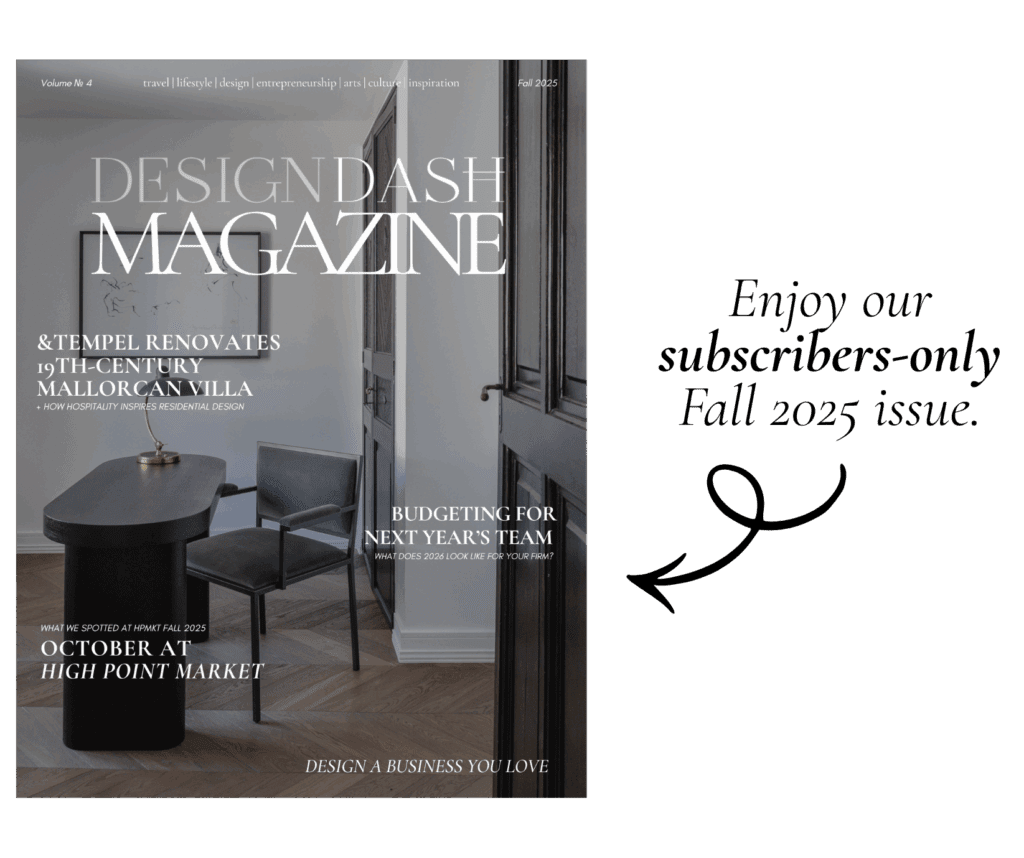
When’s the Right Time to Bring Procurement In-House Instead of Outsourcing?
Summary
Outsourcing procurement works well for smaller firms or occasional large projects, but once your studio is consistently juggling multiple installs, the hidden costs and client service trade-offs become harder to ignore. Building an in-house procurement team can increase profit margins, improve client experience, and support scalability, but it also shifts more risk and overhead onto your firm. The right timing depends on your workload, growth goals, and tolerance for complexity.
Reflection Questions
At what project volume would outsourcing fees begin to noticeably eat into my firm’s margins?
How much control over the client experience do I want my team to retain versus hand off to third parties?
If my long-term vision is growth, what infrastructure should I be building now to make procurement scalable?
Journal Prompt
Reflect on a recent project where procurement challenges slowed down the process or created stress. How might those issues have played out differently if handled by an in-house coordinator? What would have been the risks, the rewards, and the impact on the client relationship?
Procurement is one of the least visible but most critical parts of an interior design business. Behind every perfectly installed room lies hours of sourcing, ordering, tracking, receiving, and troubleshooting. Many firms start out by outsourcing procurement to third parties, but as volume grows, many are stumped with the question: should you build an in-house procurement team instead? This question touches profitability, staffing, and client service, but timing is everything.
Five Factors to Consider Before Bringing Procurement In-House
Evaluate your project load

The clearest indicator that it might be time to build an in-house team is consistent project activity. A single large install can be handled by an external partner, but if your firm is managing three to five projects at the same time, the workload usually justifies a dedicated staffer. At that scale, outsourcing fees start to eat into margins, and the consistency of an internal coordinator can streamline the entire process.
Run the cost comparison

On paper, outsourcing seems simple and easy. You pay a service fee, and someone else handles the details. Unfortunately, over time, those fees can erode margins. In-house procurement comes with its own costs (e.g., salary, benefits, software), but it also helps you capture more of the profit.
Firm owners who have built procurement into their revenue model might find bringing it in-house transforms it into a profit locus rather than an expense line. The key here is to run a true cost-benefit analysis, not just rely on your own instinct (which is still valuable but not the “be-all-end-all”).
Fuel your creative fire & be a part of a supportive community that values how you love to live.
subscribe to our newsletter
*please check your Spam folder for the latest DesignDash Magazine issue immediately after subscription

Consider the client experience
Clients rarely see the mechanics of procurement up close and personal, but they do feel its impact in their projects. In-house teams often deliver a smoother experience because they’re fully integrated into the design process.
Questions are answered faster, updates are more consistent, and issues are resolved without multiple handoffs. Outsourcing can create distance between your firm and the client if communication isn’t seamless. If your brand promise centers on high-touch service, in-house procurement may eventually be non-negotiable.
Assess your tolerance for risk

Procurement is messy work. Orders get damaged, shipments arrive late, vendors make mistakes. When you outsource, much of that risk sits with the external partner. When you bring it in-house, the responsibility lands squarely on your firm.
The tradeoff is control; your team can catch errors earlier, negotiate solutions faster, and ensure the quality of every item before it reaches the client. Owners need to decide whether they’d rather pay to offload that risk or absorb it in exchange for tighter control.
Think about scalability
Firm owners with growth ambitions might find that procurement often bottlenecks if left entirely to third parties. Building an internal team means you now have infrastructure that can scale to meet the needs of larger, more complex projects.
It also empowers you to develop long-term vendor relationships, manage warehousing more strategically, and standardize processes within your firm. If your firm’s goal is to expand into multiple markets or take on larger commercial projects, in-house procurement is almost always part of the path forward.
Inside the Studio: One Firm’s Approach to Interior Design Procurement

As any designer already knows, procurement is partially about placing orders and largely about anticipating what could go wrong. Firms must build systems that catch those issues early. “We all need a process that’s proactive, not reactive.” At LUDC, the team sits down once a week to review all active orders.

For smaller studios or solopreneurs, Laura suggests tools like Studio Designer to stay organized. “If you’re juggling multiple projects, outsourcing procurement may be the best choice. There are also procurement services out there for designers; Designer Advantage is one option for those who don’t have an in-house purchasing agent.”
So how do you know when it’s time to make the leap?
“If you’re managing three to five projects at the same time, you can absolutely justify hiring someone just to handle procurement. It really depends on the scope and type of work you’re doing.” —Laura Umansky
For firms not ready to bring on staff, she recommends blocking out time every two weeks for an “orders audit” and using a consistent checklist to ensure nothing slips through the cracks.
Join the DesignDash Community for Peer-to-Peer Support

Your eventual decision to bring procurement in-house is as much about timing as it is about ambition. Move too early, and you risk carrying overhead without enough volume. Move too late, and you’ll miss opportunities to capture profit and control the client experience.
For real-world insights from firm owners who’ve made the shift (both successfully and not), join the DesignDash Community. Inside, members share the numbers, systems, and lessons that helped them decide when procurement belonged under their firm’s own roof.
Written by the DesignDash Editorial Team
Our contributors include experienced designers, firm owners, design writers, and other industry professionals. If you’re interested in submitting your work or collaborating, please reach out to our Editor-in-Chief at editor@designdash.com.











